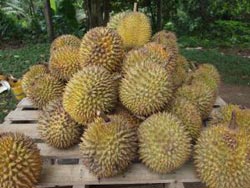Durian (Durio zibethinus L.) shell and Banana Pseudostem Fibers

Copyright : Kalai / CC<br>
This study explored the use of inexpensive materials as alternatives to treat effluents from various industries such as petroleum, metals, food processing, textile, industries as well as municipal waste waters and has become a global environmental issue.
This study explored the use of inexpensive materials as alternatives to treat effluents from various industries such as petroleum, metals, food processing, textile, industries as well as municipal wastewaters and has become a global environmental issue.
These effluents containing oil can cause serious detrimental environmental impact on the receptor water bodies and induces detrimental effects to aquatic life. It also causes serious problems to wastewater treatment plants due to its high stability and it can be separated only with the help of chemical clarification. Batch adsorption study was conducted to evaluate efficiencies of two different agriculture wastes as micro sorbent to remove oil from aqueous solution.
The agriculture waste used in this study was Durian Shell (DS) and Banana Pseudostems (BPS).
Durian shell and Banana Pseudostems are naturally occurring plants found abundantly in Malaysia. The durian fruit is a seasonal fruit which emits a pungent smell and is commonly referred to as the “King of Fruits”. The banana fruit is a non seasonal fruit and is found in abundance in Malaysia. A detailed batch study to determine its adsorption equilibrium, isotherm and kinetics was carried out at ambient temperatures, various initial concentrations of oil and stirring time. Banana pseudostem was found to be more effective than Durian Shell in removing oil from water.
Langmuir and Freundlich adsorption model were applied to describe the experimental isotherm and isotherm constants. The kinetic data was best fitted to the pseudo-second-order kinetic model. The role of DS and BPS in the removal of oil from aqueous wastes was investigated.
The researchers concluded that BPS performed exceptionally well to remove oil from aqueous solution as compared to DS.
Langmuir and Freundlich adsorption model were applied to describe the experimental isotherm and isotherm constants. Equilibrium data fitted well with Freundlich model. Thus it is reasonable to conclude that the adsorption of oil on both adsorbents that consist of heterogeneous adsorption sites are similar to each other in respect of the adsorption phenomenon. Kinetic studies indicated that the sorption of oil tend to follow pseudosecond- order kinetics for the range of studied concentrations.
This study is hoped to give rise to new avenues of exploring the possibility of using inexpensive materials to remove oil from aqueous solution.
Contact Information:
Nurul Izza Husin,
Department of Applied Sciences, UiTM Malaysia.
nurulizza.husin@ppinang.uitm.edu.my
Media Contact
All latest news from the category: Agricultural and Forestry Science
Newest articles

Red light therapy for repairing spinal cord injury passes milestone
Patients with spinal cord injury (SCI) could benefit from a future treatment to repair nerve connections using red and near-infrared light. The method, invented by scientists at the University of…

Insect research is revolutionized by technology
New technologies can revolutionise insect research and environmental monitoring. By using DNA, images, sounds and flight patterns analysed by AI, it’s possible to gain new insights into the world of…

X-ray satellite XMM-newton sees ‘space clover’ in a new light
Astronomers have discovered enormous circular radio features of unknown origin around some galaxies. Now, new observations of one dubbed the Cloverleaf suggest it was created by clashing groups of galaxies….





















